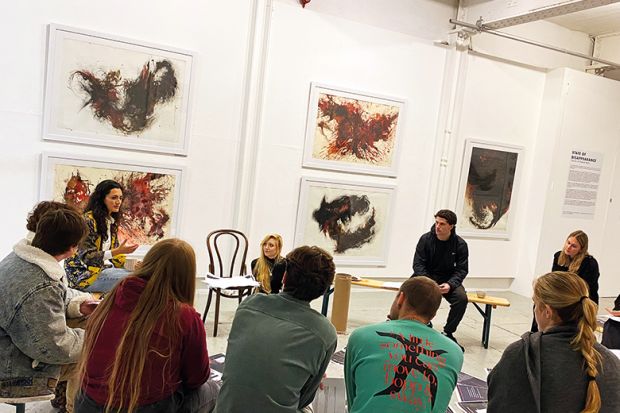Recently, I co-curated a Bristol exhibition on enforced disappearance. Showcasing the artwork of the Mexican abstract painter Chantal Meza, it sought to bring renewed attention to the multiple ways human disappearance occurs, from historical slavery to its ongoing occurrence across modern Latin America.
The exhibition was also an experiment. We wanted to see what kinds of conversations were possible by bringing art into contact with academics, policymakers and wider publics. We learned valuable lessons about the connections that can be formed with perfect strangers through our shared recognition of pain and suffering. But, as a university professor, it is the lessons for education that have preoccupied me.
A key element of the exhibition was a series of public talks with renowned authorities on different topics related to disappearance, complemented by several student workshops within the gallery setting. The students were given a tour by the artist, who spoke on how each of the pieces related to the situation in Mexico, where 100,000 people have been disappeared since 2006. The room was then set up in a circular design so attendees felt surrounded and immersed by the works as they discussed their reactions to them.
It was a revelation. From a distance, I watched as the students slowly let their guard down, speaking freely about what disappearance meant to them and their own life experiences and becoming unsettled in ways that allowed for their own fixed positions to be challenged. Meza insisted that art wasn’t “therapy” because the artist never emerges “recovered” from the process; likewise, it would be a mistake to see the students’ conversation as some kind of confessional. But it was far more intimate and far less confrontational than I’ve seen in conventional learning settings.
Just as striking was to hear the hosted speakers talk about how the experience could be a model for the types of conversations the world needs right now, recognising the other and softening interlocutors’ biases, prejudices and preconceptions.
As the exhibition closed with an emotional talk from an Afghan refugee, who brought home the need to protect those facing the very real prospect of disappearance, I recognised that the next challenge was to replicate what had taken place during those two weeks in a university setting.
Universities should be places where the imagination is set alight. Students should feel inspired by the sense of possibility that an openness to the past and future brings, daring to think differently and ask deeper questions about what it means to be human. And, as argued by the French philosopher and noted space theorist Gaston Bachelard, the aesthetic experience is crucial to creating the conditions for this.
The problem is that so many of our campuses are designed purely with uniform functionality in mind, rendering them devoid of character. If there is an aesthetic experience to be had, too often it amounts to portraits of the great and good, signalling certain values rather than seeking to spark inspiration. That might be fine for the science subjects, but this “laboratories for thought” aesthetic shouldn’t dominate the look and feel of the university, which is part of how we teach about the world. In the social sciences in particular, the absence of interplay between our visual surroundings, bodily sensations and thought – what we can term the aesthetics of thought – is acutely felt.
I know for sure that if I could teach my political violence courses within the exhibition setting – with thought put into ensuring the artworks are integral to the conversation, rather than just routine background – my students’ experience would be vastly improved. They were not in a hurry to leave the exhibition. They wanted to continue looking at the art: to consider further the aesthetics of thought. Who knows where this could lead? Yet I don’t recall a single student survey that asks whether they would like to see more engaging art on campus.
During every teaching session, students’ minds will inevitably wander for a while. We need to accommodate this because it is also part of the learning process. But where do their minds wander to when they are surrounded by empty white walls?
I am not suggesting putting up a few digital prints and inspirational quotes. My exhibition experience underlined that students, as much as the public, know the world of difference between original art and mass-produced sloganism. Can we not fill our learning spaces with original works of art, which evoke the full complexity of emotions, from anxiety to elation, despair to hope?
More deeply, at a time when the arts and humanities are in considerable crisis, maybe we need more considered relationships between the university and arts sectors, including rethinking the educational, social and political importance of gallery and museum spaces. Some galleries are no doubt taking the lead on this, but I suspect we need to go much further.
A good start might be to create new working groups to explore the aesthetic experience of education. This, after all, is inseparable from the question of what kind of graduates we wish to produce. And that, in turn, is integral to the visions for humanity we want to create. The next generation needs to feel there is a glimmer of hope in the darkest recesses of the imagination, so that the world’s problems don’t feel insurmountable.
Brad Evans is director of the Centre for the Study of Violence and professor of political violence and aesthetics at the University of Bath.
Register to continue
Why register?
- Registration is free and only takes a moment
- Once registered, you can read 3 articles a month
- Sign up for our newsletter
Subscribe
Or subscribe for unlimited access to:
- Unlimited access to news, views, insights & reviews
- Digital editions
- Digital access to THE’s university and college rankings analysis
Already registered or a current subscriber? Login








